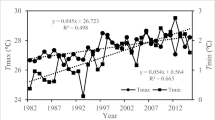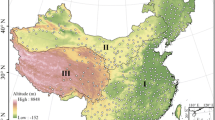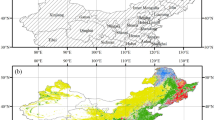Abstract
Asymmetric warming has been increasingly discussed recently, yet knowledge of this difference in warming between daytime and nighttime is still limited. Most studies of how climate warming influences the terrestrial ecosystem often ignore this asymmetric effect. We investigated the change in temperature between daytime and nighttime and analyzed the relationships between normalized difference vegetation index and the temperature in the daytime (Tmax) and the nighttime (Tmin) from 1982 to 2015 in temperate China. Results showed a faster increase in Tmin (0.46 °C dec−1, p < 0.01) during the nighttime than in Tmax (0.42 °C dec−1, p < 0.01) during the daytime, which indicated an asymmetric warming rate. The asymmetric warming during the daytime and nighttime was closely related to variations in precipitation and solar radiation. The increasing Tmin and Tmax were most pronounced over a large portion of the entire temperate China, and their warming trends displayed a non-uniform spatial distribution. The area with daytime warming was larger than that with nighttime warming, approximately accounting for 99.53% and 96.22% of temperate China, respectively. The area with warming enhancing vegetation greenness was larger during the day (71.16% of temperate China, p < 0.05) than at night (61.60% of temperate China, p < 0.05), and vice versa, which presented asymmetric warming effects on China’s temperate vegetation. We also found clear differences in the responses of the normalized difference vegetation index among different vegetation biomes to this asymmetric warming. Averagely, Tmax was significantly related to the NDVI of shrub, desert, broadleaf forest, needleleaf forest, and swamp (p < 0.01). However, this similar relationship appeared only between Tmin and desert vegetation (p < 0.01). Our findings emphasized the crucial role of asymmetric warming between the daytime maxima and nighttime minima in climate change research.





Similar content being viewed by others
References
Cao R, Shen M, Zhou J, Chen J (2018) Modeling vegetation green-up dates across the Tibetan Plateau by including both seasonal and daily temperature and precipitation. Agric For Meteorol 249:176–186. https://doi.org/10.1016/j.agrformet.2017.11.032
Collatz GJ, Bounoua L, Los SO, Randall DA, Fung IY, Sellers PJ (2000) A mechanism for the influence of vegetation on the response of the diurnal temperature range to changing climate. Geophys Res Lett 27:3381–3384. https://doi.org/10.1029/1999gl010947
Dai A, Trenberth KE, Karl TR (1999) Effects of clouds, soil moisture, precipitation, and water vapor on diurnal temperature range. J Clim 12:2451–2473. https://doi.org/10.1175/1520-0442(1999)012<2451:EOCSMP>2.0.CO;2
Davy R, Esau I, Chernokulsky A, Outten S, Zilitinkevich S (2017) Diurnal asymmetry to the observed global warming. Int J Climatol 37:79–93. https://doi.org/10.1002/joc.4688
De Jong R, Verbesselt J, Schaepman ME, De Bruin S (2012) Trend changes in global greening and browning: contribution of short-term trends to longer-term change. Glob Chang Biol 18:642–655. https://doi.org/10.1111/j.1365-2486.2011.02578.x
De La Fuente A, Bing N, Hoeschele I, Mendes P (2004) Discovery of meaningful associations in genomic data using partial correlation coefficients. Bioinformatics 20:3565–3574. https://doi.org/10.1093/bioinformatics/bth445
Easterling DR et al (1997) Maximum and minimum temperature trends for the globe. Science 277:364–367. https://doi.org/10.1126/science.277.5324.364
Folland CK, Karl TR, Jim Salinger M (2002) Observed climate variability and change. Weather 57:269–278 https://rmets.onlinelibrary.wiley.com/doi/pdf/10.1256/004316502320517353
Fu YH, Liu Y, De Boeck HJ, Menzel A, Nijs I, Peaucelle M, Penuelas J, Piao S, Janssens IA (2016) Three times greater weight of daytime than of night-time temperature on leaf unfolding phenology in temperate trees. New Phytol 212:590–597. https://doi.org/10.1111/nph.14073
Ganjurjav H, Gao QZ, Gornish ES, Schwartz MW, Liang Y, Cao XJ, Zhang WN, Zhang Y, Li WH, Wan YF, Li Y, Danjiu L, Guo HB, Lin E (2016) Differential response of alpine steppe and alpine meadow to climate warming in the central Qinghai–Tibetan Plateau. Agric For Meteorol 223:233–240. https://doi.org/10.1016/j.agrformet.2016.03.017
He B, Chen A, Jiang W, Chen Z (2017) The response of vegetation growth to shifts in trend of temperature in China. J Geogr Sci 27:801–816. https://doi.org/10.1007/s11442-017-1407-3
Jiang L, Guli J, Bao A, Guo H, Ndayisaba F (2017) Vegetation dynamics and responses to climate change and human activities in Central Asia. Sci Total Environ 599-600:967–980. https://doi.org/10.1016/j.scitotenv.2017.05.012
Karl TR, Jones PD, Knight RW, Kukla G, Plummer N (1993) Asmmetric trends of daily maximum and minimum temperature. Bull Am Meteorol Soc 74:1007–1023. https://doi.org/10.1175/1520-0477(1993)074<1007:ANPORG>2.0.CO;2
Karl TR, Kukla G, Razuvayev VN, Changery MJ, Quayle RG, Heim RR, Easterling DR, Fu CB (1991) Global warming: evidence for asymmetric diurnal temperature change. Geophys Res Lett 18:2253–2256. https://doi.org/10.1029/91gl02900
Kim Y, Kimball JS, Zhang K, McDonald KC (2012) Satellite detection of increasing Northern Hemisphere non-frozen seasons from 1979 to 2008: implications for regional vegetation growth. Remote Sens Environ 121:472–487. https://doi.org/10.1016/j.rse.2012.02.014
Li X, Zhang X, Zhang L (2017) Observed effects of vegetation growth on temperature in the early summer over the Northeast China Plain. Atmosphere:8. https://doi.org/10.3390/atmos8060097
Liu B, Xu M, Henderson M, Qi Y, Li Y (2004) Taking China’s temperature: daily range, warming trends, and regional variations, 1955-2000. J Clim 17:4453–4462. https://doi.org/10.1175/3230.1
Liu Q, Fu YH, Zeng Z, Huang M, Li X, Piao S (2016) Temperature, precipitation, and insolation effects on autumn vegetation phenology in temperate China. Glob Chang Biol 22:644–655. https://doi.org/10.1111/gcb.13081
Lobell DB (2007) Changes in diurnal temperature range and national cereal yields. Agric For Meteorol 145:229–238. https://doi.org/10.1016/j.agrformet.2007.05.002
Myneni RB, Keeling CD, Tucker CJ, Asrar G, Nemani RR (1997) Increased plant growth in the northern high latitudes from 1981 to 1991. Nature 386:698–702. https://doi.org/10.1038/386698a0
Nemani RR, Keeling CD, Hashimoto H, Jolly WM, Piper SC, Tucker CJ, Myneni RB, Running SW (2003) Climate-driven increases in global terrestrial net primary production from 1982 to 1999. Science 300:1560–1563. https://doi.org/10.1126/science.1082750
Pei F, Li X, Liu X, Wang S, He Z (2013) Assessing the differences in net primary productivity between pre- and post-urban land development in China. Agric For Meteorol 171-172:174–186. https://doi.org/10.1016/j.agrformet.2012.12.003
Peng S, Piao S, Ciais P, Myneni RB, Chen A, Chevallier F, Dolman AJ, Janssens IA, Penuelas J, Zhang G, Vicca S, Wan S, Wang S, Zeng H (2013) Asymmetric effects of daytime and night-time warming on Northern Hemisphere vegetation. Nature 501:88–92. https://doi.org/10.1038/nature12434
Piao S, Fang J, Zhou L, Ciais P, Zhu B (2006) Variations in satellite-derived phenology in China’s temperate vegetation. Glob Chang Biol 12:672–685. https://doi.org/10.1111/j.1365-2486.2006.01123.x
Piao S, Tan J, Chen A, Fu YH, Ciais P, Liu Q, Janssens IA, Vicca S, Zeng Z, Jeong SJ, Li Y, Myneni RB, Peng S, Shen M, Peñuelas J (2015) Leaf onset in the northern hemisphere triggered by daytime temperature. Nat Commun 6:6911. https://doi.org/10.1038/ncomms7911
Piao S, Wang X, Ciais P, Zhu B, Wang T, Liu J (2011) Changes in satellite-derived vegetation growth trend in temperate boreal Eurasia from 1982 to 2006. Glob Chang Biol 17:3228–3239. https://doi.org/10.1111/j.1365-2486.2011.02419.x
Poulter B, Pederson N, Liu H, Zhu Z, D’Arrigo R, Ciais P, Davi N, Frank D, Leland C, Myneni R, Piao S, Wang T (2013) Recent trends in Inner Asian forest dynamics to temperature and precipitation indicate high sensitivity to climate change. Agric For Meteorol 178-179:31–45. https://doi.org/10.1016/j.agrformet.2012.12.006
Qu L, Xiao H, Zheng N, Zhang Z, Xu Y (2017) Comparison of four methods for spatial interpolation of estimated atmospheric nitrogen deposition in South China. Environ Sci Pollut Res 24:2578–2588. https://doi.org/10.1007/s11356-016-7995-0
Rossi S, Isabel N (2017) Bud break responds more strongly to daytime than night-time temperature under asymmetric experimental warming. Glob Chang Biol 23:446–454. https://doi.org/10.1111/gcb.13360
Sadras VO, Moran MA (2013) Asymmetric warming effect on the yield and source: sink ratio of field-grown grapevine. Agric For Meteorol 173:116–126. https://doi.org/10.1016/j.agrformet.2012.12.005
Shen M, Piao S, Chen X, An S, Fu YH, Wang S, Cong N, Janssens IA (2016) Strong impacts of daily minimum temperature on the green-up date and summer greenness of the Tibetan Plateau. Glob Chang Biol 22:3057–3066. https://doi.org/10.1111/gcb.13301
Shen M, Tang Y, Chen J, Yang W (2012) Specification of thermal growing season in temperate China from 1960 to 2009. Clim Chang 114:783–798. https://doi.org/10.1007/s10584-012-0434-4
Shen X, Liu B, Li G, Wu Z, Jin Y, Yu P, Zhou D (2014) Spatiotemporal change of diurnal temperature range and its relationship with sunshine duration and precipitation in China. J Geophys Res-Atmos 119:13163–13179. https://doi.org/10.1002/2014JD022326
Shen X, Liu B, Li G, Zhou D (2015) Impact of climate change on temperate and alpine grasslands in China during 1982–2006. Adv Meteorol 2015:1–10. https://doi.org/10.1155/2015/180614
Su H, Li G (2012) Simulating the response of the Quercus mongolicaforest ecosystem carbon budget to asymmetric warming. Chin Sci Bull (Chinese Version) 57:1544–1552. https://doi.org/10.1360/972012-236
Tan J, Piao S, Chen A, Zeng Z, Ciais P, Janssens IA, Mao J, Myneni RB, Peng S, Penuelas J, Shi X, Vicca S (2015) Seasonally different response of photosynthetic activity to daytime and night-time warming in the Northern Hemisphere. Glob Chang Biol 21:377–387. https://doi.org/10.1111/gcb.12724
Turnbull MH, Murthy R, Griffin KL (2002) The relative impacts of daytime and night-time warming on photosynthetic capacity in Populus deltoides. Plant Cell Environ 25:1729–1737. https://doi.org/10.1046/j.1365-3040.2002.00947.x
Vose RS, Easterling DR, Gleason B (2005) Maximum and minimum temperature trends for the globe: an update through 2004. Geophys Res Lett 32. https://doi.org/10.1029/2005gl024379
Wan S, Xia J, Liu W, Niu S (2009) Photosynthetic overcompensation under nocturnal warming enhances grassland carbon sequestration. Ecology 90:2700–2710. https://doi.org/10.1890/08-2026.1
Wang L, Lee X, Schultz N, Chen S, Wei Z, Fu C, Gao Y, Yang Y, Lin G (2018) Response of surface temperature to afforestation in the Kubuqi Desert, Inner Mongolia. J Geophys Res-Atmos 123:948–964. https://doi.org/10.1002/2017jd027522
Welch JR, Vincent JR, Auffhammer M, Moya P, Dobermann A, Dawe D (2010) Rice yields in tropical/subtropical Asia exhibit large but opposing sensitivities to minimum and maximum temperatures. PNAS 107:14562–14567. https://doi.org/10.1073/pnas.1001222107
Wu X, Liu H, Li X, Liang E, Beck PS, Huang Y (2016) Seasonal divergence in the interannual responses of Northern Hemisphere vegetation activity to variations in diurnal climate. Sci Rep 6:19000. https://doi.org/10.1038/srep19000
Wu Z, Wu J, Liu J, He B, Lei T, Wang Q (2013) Increasing terrestrial vegetation activity of ecological restoration program in the Beijing–Tianjin Sand Source Region of China. Ecol Eng 52:37–50. https://doi.org/10.1016/j.ecoleng.2012.12.040
Xia J, Chen J, Piao S, Ciais P, Luo Y, Wan S (2014) Terrestrial carbon cycle affected by non-uniform climate warming. Nat Geosci 7:173–180. https://doi.org/10.1038/ngeo2093
Yang Z, Jiang L, Su F, Zhang Q, Xia J, Wan S (2016) Nighttime warming enhances drought resistance of plant communities in a temperate steppe. Sci Rep 6:23267. https://doi.org/10.1038/srep23267
You Q, Kang S, Aguilar E, Pepin N, Flügel WA, Yan Y, Xu Y, Zhang Y, Huang J (2010) Changes in daily climate extremes in China and their connection to the large scale atmospheric circulation during 1961–2003. Clim Dyn 36:2399–2417. https://doi.org/10.1007/s00382-009-0735-0
Zhang X, Tang Q, Zheng J, Ge Q (2013) Warming/cooling effects of cropland greenness changes during 1982–2006 in the North China Plain. Environ Res Lett 8:024038. https://doi.org/10.1088/1748-9326/8/2/024038
Zheng J, Yin Y, Li B (2010) A new scheme for climate regionalization in China. Acta Geograph Sin 65:3–12. https://doi.org/10.11821/xb201001002
Zhou L, Dai A, Dai Y, Vose RS, Zou C-Z, Tian Y, Chen H (2008) Spatial dependence of diurnal temperature range trends on precipitation from 1950 to 2004. Clim Dyn 32:429–440. https://doi.org/10.1007/s00382-008-0387-5
Zhou L, Tucker CJ, Kaufmann RK, Slayback D, Shabanov NV, Myneni RB (2001) Variations in northern vegetation activity inferred from satellite data of vegetation index during 1981 to 1999. J Geophys Res 106:20069–20083. https://doi.org/10.1029/2000JD000115
Zhu Z, Piao S, Myneni RB, Huang M, Zeng Z, Canadell JG, Ciais P, Sitch S, Friedlingstein P, Arneth A, Cao C, Cheng L, Kato E, Koven C, Li Y, Lian Y, Liu Y, Mao J, Pan Y, Peng S, Peñuelas J, Poulter B, Pugh TAM, Stocker BD, Viovy N, Wang X, Wang Y, Xiao Z, Yang H, Zaehle S, Zeng N (2016) Greening of the Earth and its drivers. Nat Clim Chang 6:791–795. https://doi.org/10.1038/nclimate3004
Acknowledgments
The authors are grateful for the comments from the editor and anonymous reviewers.
Funding
The work was financially supported by the National Natural Science Foundation of China (U1810101, 41161066, and 41871193), and the Important Specialized Science and Technology Item of the Shanxi Province (Grant no.20121101011).
Author information
Authors and Affiliations
Corresponding author
Additional information
Responsible editor: Hailong Wang
Publisher’s note
Springer Nature remains neutral with regard to jurisdictional claims in published maps and institutional affiliations.
Rights and permissions
About this article
Cite this article
Du, Z., Zhao, J., Liu, X. et al. Recent asymmetric warming trends of daytime versus nighttime and their linkages with vegetation greenness in temperate China. Environ Sci Pollut Res 26, 35717–35727 (2019). https://doi.org/10.1007/s11356-019-06440-z
Received:
Revised:
Accepted:
Published:
Issue Date:
DOI: https://doi.org/10.1007/s11356-019-06440-z




